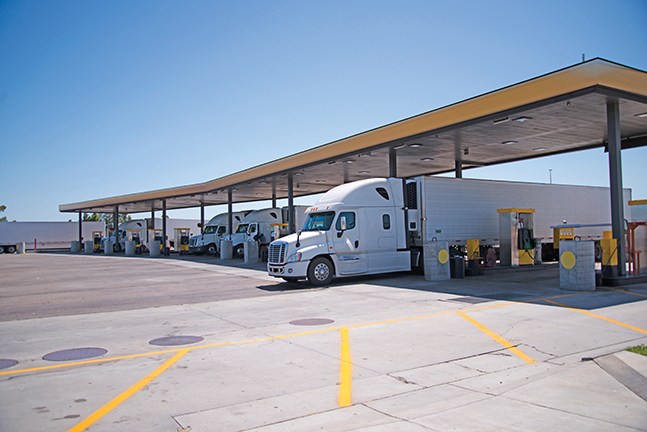Around the world, demand for oil continues to rise. The result is, as always, increased prices at the pump — and the trucking industry is feeling the pain.
There are multiple reasons for the increase, including what seems the most popular explanation that President Joe Biden’s administration is responsible. While it’s true that Biden has taken some actions that could impact oil supply (and therefore pricing) in the future, other events have taken place that have had a much greater impact on oil futures.
One of the largest impacts has simply been the return of demand for oil and fuel to pre-COVID levels. As the world economy slowly emerges from shutdowns and restrictions, more people are driving and flying. Ships are bringing overseas imports. Rail lines have more product to move.
On Nov. 3, 2020, Election Day, the national average retail price of a gallon of highway diesel fuel was $2.37, according to data released by the U.S. Energy Information Administration (EIA). That same week, a barrel of “Brent” oil — the light, sweet crude that is the benchmark for oil pricing worldwide — sold for $36.81.
By Inauguration Day, Jan. 20, 2021, diesel prices had risen for 12 consecutive weeks to an average of $2.70 per gallon, a 13.9% increase. The crude oil used to make the diesel rose in price to $47.62, an increase of 29.4%.
As of the last week of March, the price of a gallon of diesel had reached $3.20 and a barrel of oil went for $61.55. That’s a 35% increase in diesel pricing, driven by a 67.2% increase in the cost of crude oil.
The severe winter weather that hit Texas and the U.S. Gulf Coast, resulting in the coldest three-day stretch in recorded history, wreaked havoc on the oil industry. Crude oil pumped from the ground is accompanied by water and water vapor, which accompany the oil through pipelines and valves.
Just as small ice particles can shut down fuel flow to a diesel truck engine, they can also plug valves and filters in oil pipelines. Pipelines stopped flowing and production was halted, or at least restricted, at multiple refineries, reducing supplies and pushing pricing upward.
Then there’s OPEC. The Organization of the Petroleum Exporting Countries that started with only five members today has 14. Add 10 more countries, including Russia and Mexico, and the organization becomes OPEC+. Altogether, OPEC+ controls 55% of the world’s oil supply and 90% of its reserves.
The organization exists to coordinate and unify the petroleum policies of its member countries. It does this by seeking agreements on oil production by its members, keeping the supply in balance with demand so that prices remain stable.
OPEC+ agreed to slash oil production in May 2020 in response to pricing crashes caused by COVID shutdowns. The barrel price of oil had already dropped to around $20 per barrel in March before hitting rock-bottom in the third week of April 2020. In that week, the barrel price reached $9.06 before finishing another day in negative territory. Slowly, the organization has raised production levels, attempting to match world needs while maintaining prices.
In early March of this year, the organization announced that it would continue present production cuts into April, raising concerns that oil supply will not grow along with demand as the world economy reopens.
The EIA predicts that crude oil prices will stabilize as the market becomes more balanced, settling in at around $58 per barrel in the second half of 2021. The agency cautions, however, that future production decisions from OPEC+ could impact the prediction. Higher prices could also stimulate more production in the U.S., which would also impact the market. Many drilling operations and wells were shut down as demand fell during COVID-19, but higher pricing could incentivize reopening.
Another event with the potential to impact oil pricing occurred in late March when a large container ship became lodged in the Suez Canal, blocking all ship movement for nearly a week. Oil tankers bound from the Middle East to Europe, Asia and the U.S. use the canal. With hundreds of ships waiting for the canal to reopen, some chose to re-route around the southern tip of Africa. Both the delays and extra miles add transportation costs to the products being shipped.
Finally, let’s go back and look at that election. On Nov. 4, 2019, a year before the presidential election and months before COVID-19 began to impact the economy, the national average price of a gallon of oil was $3.06. It hadn’t changed much by mid-January 2020, a year before the Biden inauguration.
As COVID-19 shutdowns and travel restrictions occurred, however, the price fell steadily for 19 consecutive weeks, reaching a low of $2.39 per gallon in mid-May. By the November 2020 election, after five months of the lowest diesel prices since 2016, it had fallen to $2.37.
As the calendar turns to April 2021, diesel prices are only about 14 cents per gallon above where they were pre-COVID. Crude oil prices are currently at about the same level they were before the pandemic.
To be sure, the Biden administration has taken some actions that could impact long-term petroleum pricing. Executive orders that stopped new drilling and fracking on public lands, as well as a review of leases due for renewal, could slow future production. The order halting construction of the XL pipeline has no effect in the short term, since no oil was being transported yet. As Canada continues to exploit its oil sands reserves, however, the loss of the expected pipeline could add costs as alternate shipping options are used.
The administration’s commitment to electric vehicles will eventually have an additional impact on the petroleum industry, but that impact is years away.
For the present, the prices of crude oil and the products made from it should soon stabilize, perhaps even declining slightly in coming months. In fact, the March 29 fuel pricing update from EIA showed the first decline in the national average price in 22 weeks. That’s a welcome outcome for trucking as carriers attempt to control costs even as they benefit from higher freight rates.
Still, much depends on the pace of the COVID-19 recovery, including ongoing vaccination programs, no adverse actions by OPEC+ and an absence of world events that could upset the supply and demand balance.
Cliff Abbott is an experienced commercial vehicle driver and owner-operator who still holds a CDL in his home state of Alabama. In nearly 40 years in trucking, he’s been an instructor and trainer and has managed safety and recruiting operations for several carriers. Having never lost his love of the road, Cliff has written a book and hundreds of songs and has been writing for The Trucker for more than a decade.















